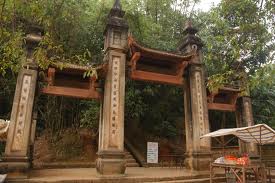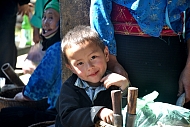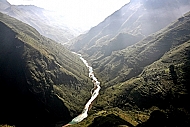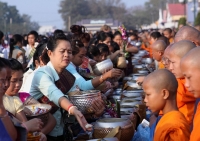Tay Phuong pagoda, the collection of vietnamese buddhist sculture, the art of vietnamese buddhism dates back the 16th
Tay Phuong pagoda has the most interesting colletion of arhats <la han> in Vietnam
one of the most attractive pagoda in outskirt of Hanoi
the favorite destination for day trip to visit Thay Pagoda, Tay Phuong Pagoda, Duong lam old village, and the rural area
 The pagoda was built in the 8th century and has been restored several times since. In 1632, the pagoda was rebuilt according to the Sino-Vietnamese character Tam (three), featuring three sections: the upper sanctuary, back palace, and lobby rooms.
The pagoda was built in the 8th century and has been restored several times since. In 1632, the pagoda was rebuilt according to the Sino-Vietnamese character Tam (three), featuring three sections: the upper sanctuary, back palace, and lobby rooms.
After climbing 239 stone steps bearing the signs of the passage of time and sheltered by the shade of age-old trees one reaches a gate. The gate carries the name of the structure: Tay Phuong Co Tu (Ancient Pagoda of the West). According to the inscription on a 17th century stone stele it also has two other names: Sung Phuc Tu and Hoang Son Thieu Lam Tu.
In 1794 under the Tay Son regime, it was completely renewed, hence its present design. It comprises three successive constructions: the Hall of Prostration, the Main Shrine, and the Sanctuary, all with doubletiered roofs. It seems that this architectural arrangement is inspired by Buddhist and Confucianist thought: the three constructions symbolize the three forces governing the world.
The central construction has a directing role and is consequently raised higher than the others. It symbolizes Heaven. The construction at the rear plays the role of a foundation: it symbolizes the earth. The construction closest to the world of man stands in front. The whole structure is the symbol of Thai Cuc (the Prime Principle, from which the whole world derives). The double tier of the roof symbolizes the double principle, Luong Nghi, yin and yang. The slopes, the roof on the four sides symbolize the four elements of heaven, Tu Tuong; the sun
, moon, stars and deities, while the slopes on the eight sides stand for the Eight Signs of the Sacred Octagon (Bat Quai).Â
All the wooden parts of the pagoda are beautifully sculpted following folk motifs: mulberry leat Ficus leat lotus flower, chrysanthemum; dragon, phoenix, etc. But the Tay Phuong Pagoda is mostly famous for the statues it contains, magnificent wooden sculptures representing Buddhas as well as Vajrapanis (Kim Cuong) and Arhats (La Han) who are middle-ranking Buddhist deities. One in particular portrays Sakyamuni in meditation at the foot of Tuyet Son (Snow Mountain). He was then leading a life of extremely severe ascetics, and his emaciated body, as represented by the statue, shows good knowledge by the artist of human anatomy. The figures of the Arhats each bear distinctive features which depict meditation in original aspects. All are impressive works of art.
 |
 |
A festival is held in the grounds of the Tay Phuong Pagoda in early spring each year. It features many games and entertainment: marionette performances, tug-of-war, cock fighting, chess with human chess pieces... The central piece of the festival is the Sam Hoi (Expiation) ceremony, held on the 6th day of the 3rd lunar month, which calls on all men to practise compassion and charity, to avoid wrong doing, and aim for serenity and quietude.













 The pagoda was built in the 8th century and has been restored several times since. In 1632, the pagoda was rebuilt according to the Sino-Vietnamese character Tam (three), featuring three sections: the upper sanctuary, back palace, and lobby rooms.
The pagoda was built in the 8th century and has been restored several times since. In 1632, the pagoda was rebuilt according to the Sino-Vietnamese character Tam (three), featuring three sections: the upper sanctuary, back palace, and lobby rooms. 












